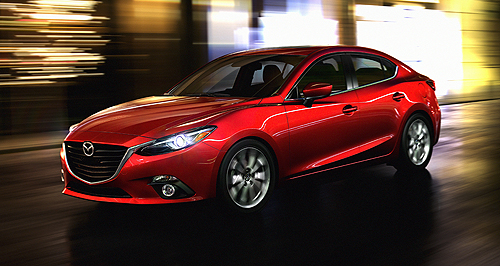Make / Model Search
News - Mazda - Mazda3MX-5 sets Mazda3 behaviourLike they used to: Mazda has gone back to its roots, using an original MX-5 as a benchmark for the new Mazda3 steering. Mazda benchmarks MX-5 roadster to sharpen up '3' small-car's dynamics15 Jul 2013 By BYRON MATHIOUDAKIS in LOS ANGELES MAZDA has used a two-seat sportscar to set ride and handling benchmarks for the next generation of its strong-selling city hatchback. Speaking at the launch of the Mazda3 in Los Angeles last week, North American vehicle evaluation and “technobabble” manager David Coleman said a clean-sheet design allowed the Japanese car-maker to tailor the city hatchback’s driving characteristics to that of the iconic convertible. “We wanted to benchmark the best … and that meant the MX-5 Miata,” Mr Coleman said. “For steering feel, using an electric power steering system, a lot of effort went into making it feel great and communicative. “Usually Mazda benchmarks BMW… but we couldn’t find cars out there with the right feel – so we went to our MX-5.” Using a first-generation (1989-97) US-market NA Miata competition car with no power steering, Mazda strove to emulate its handling and response, with the goal of resetting dynamic standards for communication and control. Engineers have also built passive steering into the rear suspension, with the bushes deflecting under cornering load to give a more linear, controlled response. “We wanted a non-electric feel,” Mr Coleman said. “We wanted to bring manual steering feel without the weight. On centre it is lighter than before but is heavier on the turn. “The rear suspension is designed to have a natural response to a side-load – so bushing deflection is faster for straight-line stability. “As a result, while the previous Mazda3 has a three degrees of caster angle, the new one is at 6.5 degrees – and that’s at rear-wheel-drive levels, and the same as our MX-5 and RX-8. “This is the highest caster angle of any front-drive car. We built it this way to put more force on the steering – making it heavier mechanically and lighter electrically, we can get exactly the feel.” Previous versions of the Mazda3 (2004 BK and current 2009 BL) were based on Ford’s C1 Focus architecture. However, the platform also had to underpin premium brand Volvo’s S40/V50 small car series, limiting Mazda’s ability to inject brand DNA into the shared architecture. “Engineering all components of a car simultaneously is a very rare event because of varying timeframes and legacy situations,” Mr Coleman said. “But for the new Mazda3 a clean-sheet, back-to-fundamentals approach to problem solving meant we could optimise the engineering on an unprecedented scale.” Like the Focus and all 90kW-plus Volkswagen Golf models, the new Mazda3 uses a MacPherson strut front and multilink rear suspension, as well as electric rack and pinion steering. To improve dynamics, the new Mazda3 weighs 70kg less than before, has a lower centre of gravity, a 30 per cent stiffer structure, reduced front and rear overhangs, and a body-in-white featuring 60 per cent high-strength steels – 10 per cent higher than before. Ultra high-strength steels are used in the B-pillars and bumper ends to reduce unsprung weight. The extra structural bracing combined with the new suspension geometry also led to improved noise, vibration, and harshness properties, as well as provided a more pliant ride on bigger-wheeled models. “Getting the suspension geometry more to our liking also helped make a quieter and more comfortable car,” Mr Coleman said. “Using a lighter rear-trailing arm helps… and also quieter tyres, stiffer body, and the pinpointing of noise paths, such as the ones we discovered entering from behind the front wheel arch area. “But adding sound-deadening material isn’t ideal because of its weight so there are custom NVH panels to pinpoint that problem in some parts of the car.” While the hardware is the same for more than 120 markets worldwide, there are four chassis tuning and tyre configurations – US (all weather), European (high-speed control), Japan (low-speed comfort and economy), and “Rest of World” (maximising grip and performance on low rolling-resistance summer tyres). The latter applies to Australian-bound 3s. Though engineered in Japan, each chassis tune was honed in their respective territories. However, Australia did not figure in ROW testing despite the 3’s bestseller status here. Of the four four-cylinder engines announced worldwide so far, Australia will miss out on the 75kW 1.5-litre petrol unit and go straight for a revised version of the SkyActiv-G 2.0-litre unit producing 114kW of power and 200Nm of torque, driving the front wheels via a six-speed manual or six-speed automatic transmission. Both transmissions evolved from the SkyActiv development program, with the manual ranking as Mazda’s first all-new three-pedalled shifter since the 1980s. The larger 2.5-litre engine shared with the Mazda6 and CX-5 offers 138kW and 250Nm, with Australia being the only market in the world for now to pair the latter with the manual gearbox. However what Mazda gives it also takes away – in Australia the 2.5-litre auto version of the 3 will not include a “Sport” button that retunes the transmisison to hold gears for longer. Both SkyActiv-G petrol engines offer a high 13:1 compression ratio and open-throttle Miller cycle cruising using electric variable valve timing to optimise power, torque and fuel economy. But the i-Eloop brake energy regeneration system offered on the Mazda6 will also be denied to Australian Mazda3 buyers due to cost and complexity issues. Nevertheless, the 70kg weight loss and a move to Mazda’s fiel efficiency-enhanced ‘4-2-1’ exhaust system, the newcomer’s combined average fuel use may drop as low as the 5.7 litre per 100km (2.0) and 6.1L/100km (2.5) figures quoted for other markets. Meanwhile, don’t expect the 129kW/420Nm 2.2-litre SkyActiv-D turbo-diesel before the end of next year at the earliest as Mazda ramps up production to meet European demand.  Read more |
Click to shareMotor industry news |












Facebook Twitter Instagram